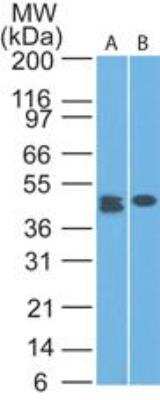CLEC9A Mouse Monoclonal Antibody [Clone ID: 14N8D7]
Frequently bought together (1)
beta Actin Mouse Monoclonal Antibody, Clone OTI1, Loading Control
USD 200.00
Other products for "CLEC9A"
Specifications
| Product Data | |
| Clone Name | 14N8D7 |
| Applications | WB |
| Recommended Dilution | Western Blot: 1-3ug/ml |
| Reactivities | Human, Primate |
| Host | Mouse |
| Isotype | IgG1, kappa |
| Clonality | Monoclonal |
| Immunogen | A portion of amino acids 50-130 of human CLEC9A was used as the immunogen for the antibody. 60 74 |
| Formulation | PBS containing 0.05% BSA, 0.05% Sodium Azide. Store at 4C. Do not freeze. |
| Concentration | lot specific |
| Purification | Protein G purified |
| Conjugation | Unconjugated |
| Storage | Store at -20°C as received. |
| Stability | Stable for 12 months from date of receipt. |
| Gene Name | C-type lectin domain family 9 member A |
| Database Link | |
| Background | CLEC9A is a group V CTLR (C-type lectin-like receptor) that functions as an activation receptor and is expressed on myeloid lineage cellsThis protein is also expressed at the cell surface and acts as glycosylated dimers which mediate endocytosis, but not phagocytosis (Poulin LF et al, 2010). It facilitates antigen uptake and presentation, and may provide a suitable target for antibody-mediated antigen delivery. CLEC9A is important for conveying information from necrotic cells to T-cells and defines a pathway by which adaptive immune responses can be initiated in the absence of infection (Huysamen C et al, 2008). It recruits Syk to mediate sensing of necrosis by the principal DC subset involved in regulating cross priming to cell-associated antigens (Sancho D et al, 2009). Signaling via this kinase occurs through a novel pathway involving CARD9 which induce a variety of cellular responses including the induction of cytokines (such as TNF, IL-6, IL-10, IL-23, and IL-2), the respiratory burst, and the production of Arachidonic acid (Caminschi I et al, 2008). In addition, it also induces TH17 (T-helper type 17) adaptive responses in vivo. Expression of CLEC9A is highly restricted in peripheral blood, being detected only on BDCA3+ DCs and on a small subset of CD14+ CD16- monocytes. CLEC9A serves as a new marker to distinguish subtypes of DCs. Targeting antigens to DCs with antibodies to CLEC9A is a promising strategy to enhance the efficiency of vaccines, even in the absence of adjuvants (Sancho D et al, 2008). |
| Synonyms | CD370; DNGR-1; DNGR1; UNQ9341 |
| Reference Data | |
| Protein Families | Transmembrane |
Documents
| Product Manuals |
| FAQs |
| SDS |
{0} Product Review(s)
0 Product Review(s)
Submit review
Be the first one to submit a review
Product Citations
*Delivery time may vary from web posted schedule. Occasional delays may occur due to unforeseen
complexities in the preparation of your product. International customers may expect an additional 1-2 weeks
in shipping.






























































































































































































































































 Germany
Germany
 Japan
Japan
 United Kingdom
United Kingdom
 China
China



